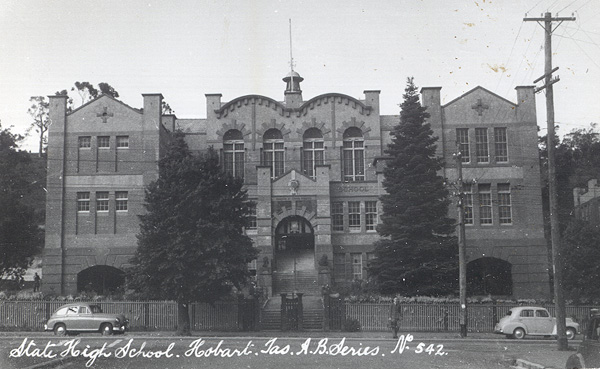 |
 |
|
Secondary Education (State)
Public education in Tasmania was limited to primary schools until 1913, when selective state high schools in Hobart and Launceston accepted their first students. A Council of Education had been established in 1860 to encourage the growth of higher education. It conducted examinations for children aged about 13, 16 and 19 (the last for two scholarships to English universities). On average, only about fifteen students each year qualified for the certificates it awarded, almost all from independent schools. Towards the end of the century, the government offered a small number of scholarships for state school graduates to study at a private secondary school. There had always been a few students completing the primary curriculum before reaching the school-leaving age, and some of these had stayed on doing extra study. In 1910 a Seventh Class was introduced, not merely to encourage students, and their parents, to look beyond the primary school, but to demonstrate that significant demand for this existed. This achieved both aims, and soon afterwards the high schools were established. There was surprisingly little opposition from the independent school sector, which felt it would cater to a different class of student. The high schools initially offered five career-based courses: academic, teaching, commercial, industrial, and domestic. Enrolments were encouraging, although a small proportion of those completing primary school, and there was soon a concern that many did not stay to complete the courses. High schools opened in Burnie and Devonport in 1916, although at first these were 'intermediate' (two years rather than four). In 1919 the industrial course was transferred to new junior technical schools in Hobart, Launceston, Queenstown and Zeehan. The domestic course was a complete failure and was abandoned, although domestic science was made a compulsory subject for girls. The academic and teaching courses were merged during the 1920s. From 1922 courses were extended to three years for a new Intermediate Certificate, followed by two years leading to the Leaving examination. Enrolments increased steadily and by the mid-1930s there were insufficient places available for all those who achieved the entrance standard. To relieve the pressure, a separate commercial high school was opened at New Town in Hobart (later renamed the A.G. Ogilvie Memorial High School in honour of the late premier). Despite some early criticisms the schools were widely accepted and their graduates well regarded. In style, they seemed more to resemble their private counterparts than not, although they had a distinctively meritocratic air. In the late 1930s a struggle took place for the control of the curriculum between the Education Department, which favoured a broader general education, and the University. The Department won control of the Intermediate years, and at the end of the war extended this to the first four years, leaving the fifth year and matriculation in the hands of the University. The Department's reformers also had plans for those children who did not progress beyond primary school. Area schools in rural districts in the late 1930s offered a post-primary curriculum based on practical subjects and citizenship, and the raising of the leaving age to 16 in 1946 saw the introduction of their urban equivalent: the modern schools. While this completed the structure envisaged by the reformers four decades earlier, there were social and economic changes in the wind which would lead to further changes. While the area schools had been a big success and the modern schools were admirable in their own way, neither was suited to the aspirations of the post-war world, and they came to be regarded as second-class, especially as many students were being denied high school places only because there were too few available. The solution was the gradual adoption of the district and comprehensive principles, whereby all students attended a local high school which offered courses to suit all needs. The many new schools built to cope with the baby-boom generations began on this basis, and the existing specialist schools gradually adopted it. New Town (technical) and Ogilvie (commercial) high schools in Hobart became the only Tasmanian state single-sex high schools because of the existing composition of their student intakes (no girls at the former, very few boys at the latter). The growing demand for study at the academic level led to the establishment of matriculation colleges in the larger centres: the four original selective high schools were transformed into the new colleges, and the remaining high schools catered for the first four years of secondary schooling, up to the compulsory age. At the time of writing this structure remains in place, though there have been many changes in the style and curriculum of the high schools, and most students now stay at school to Year 12, beyond the compulsory age. Michael Sprod |
Copyright 2006, Centre for Tasmanian Historical Studies |
